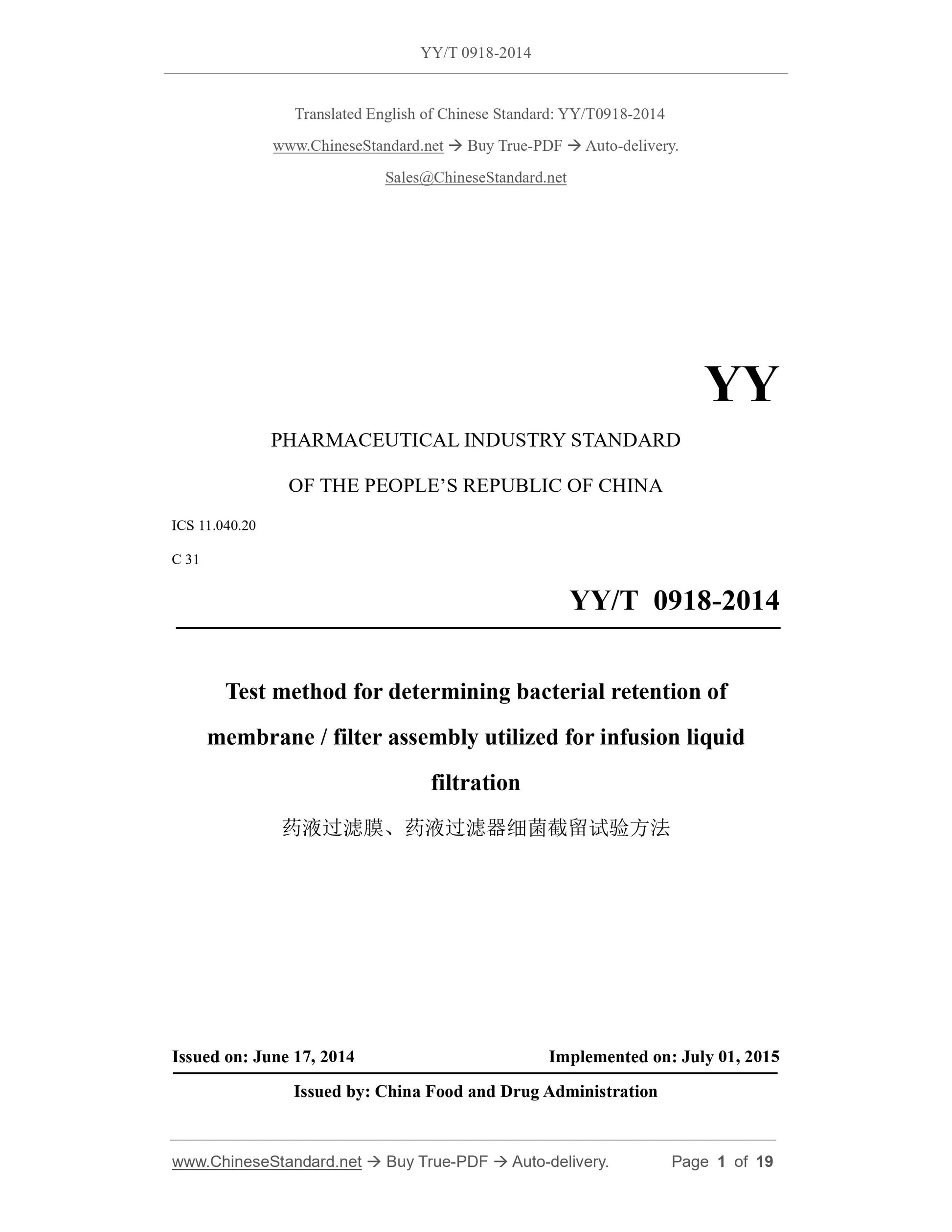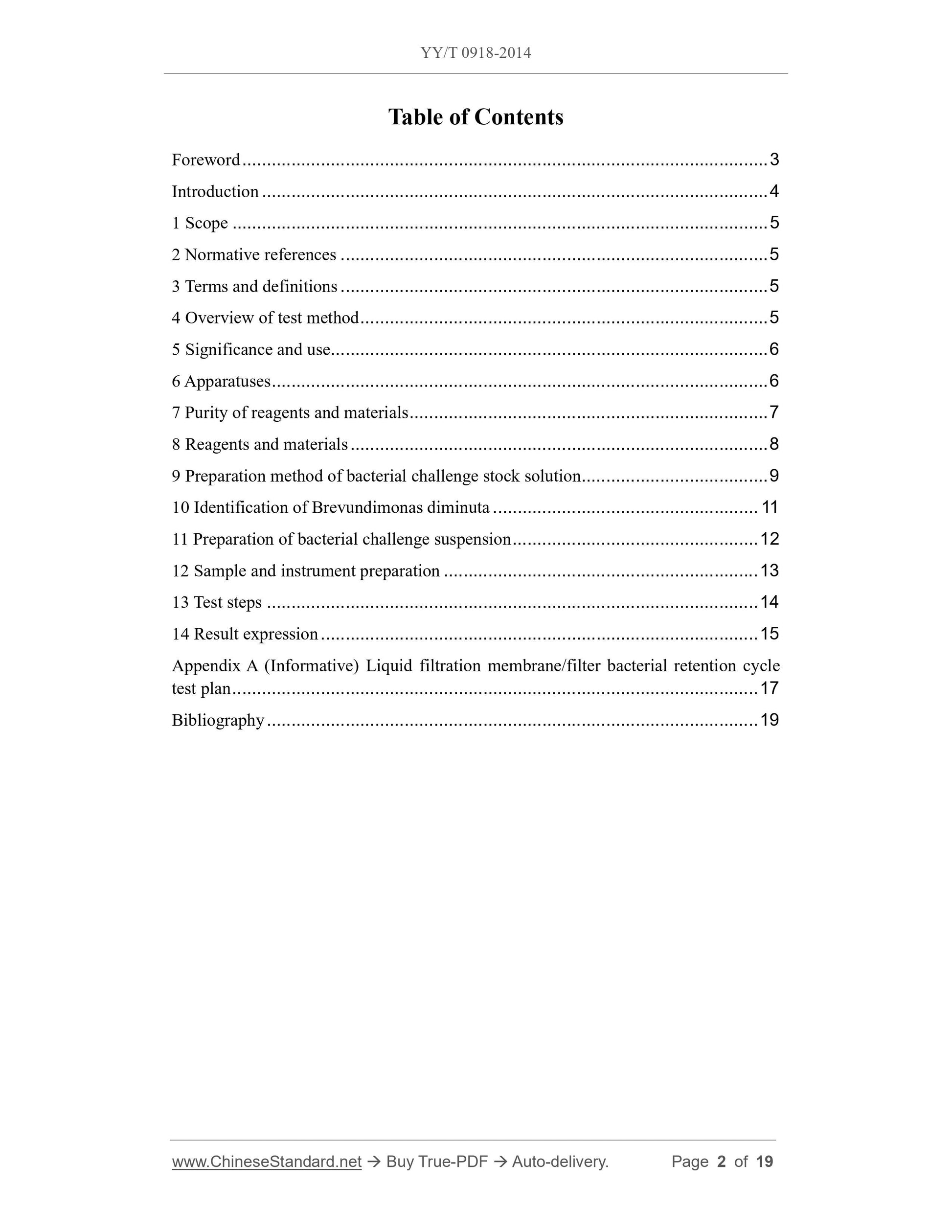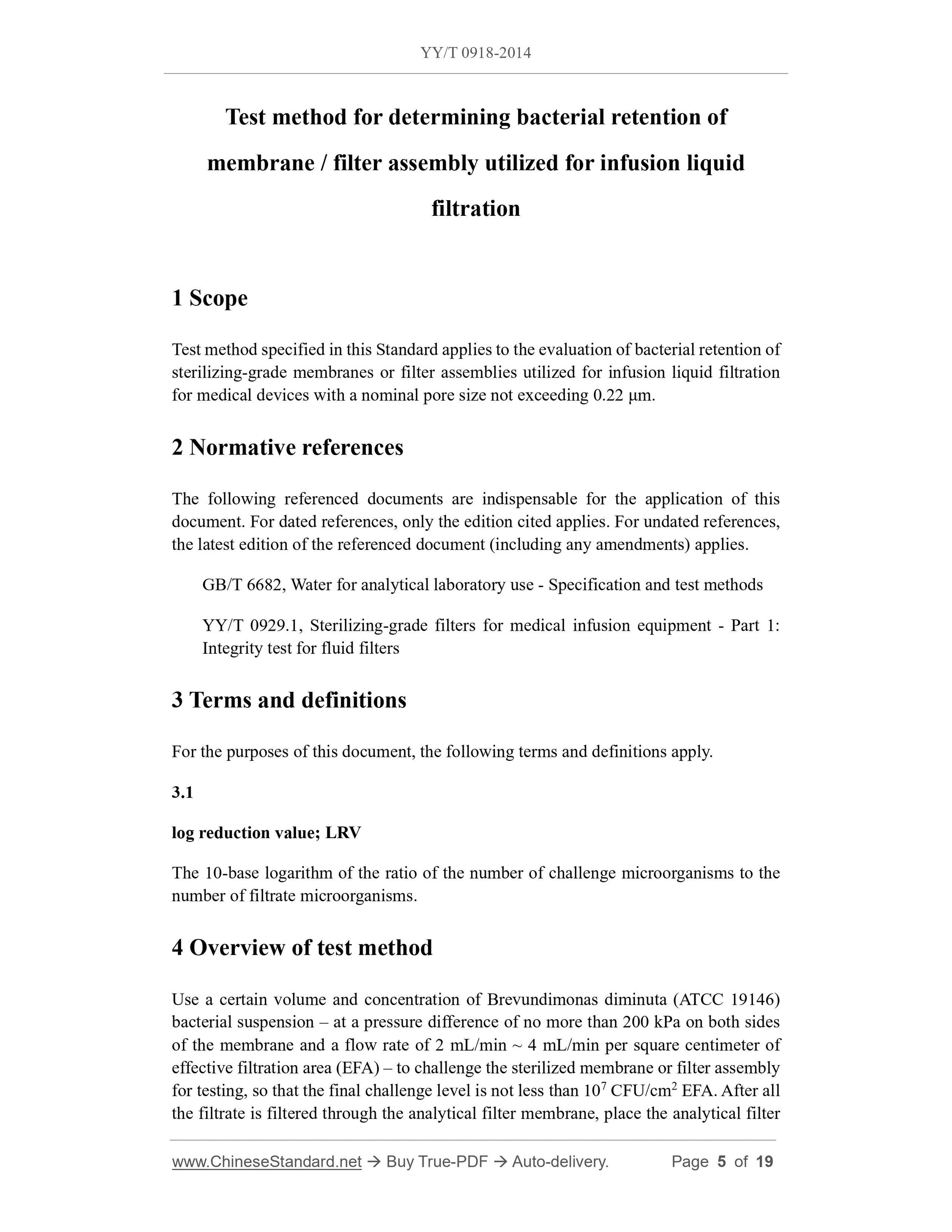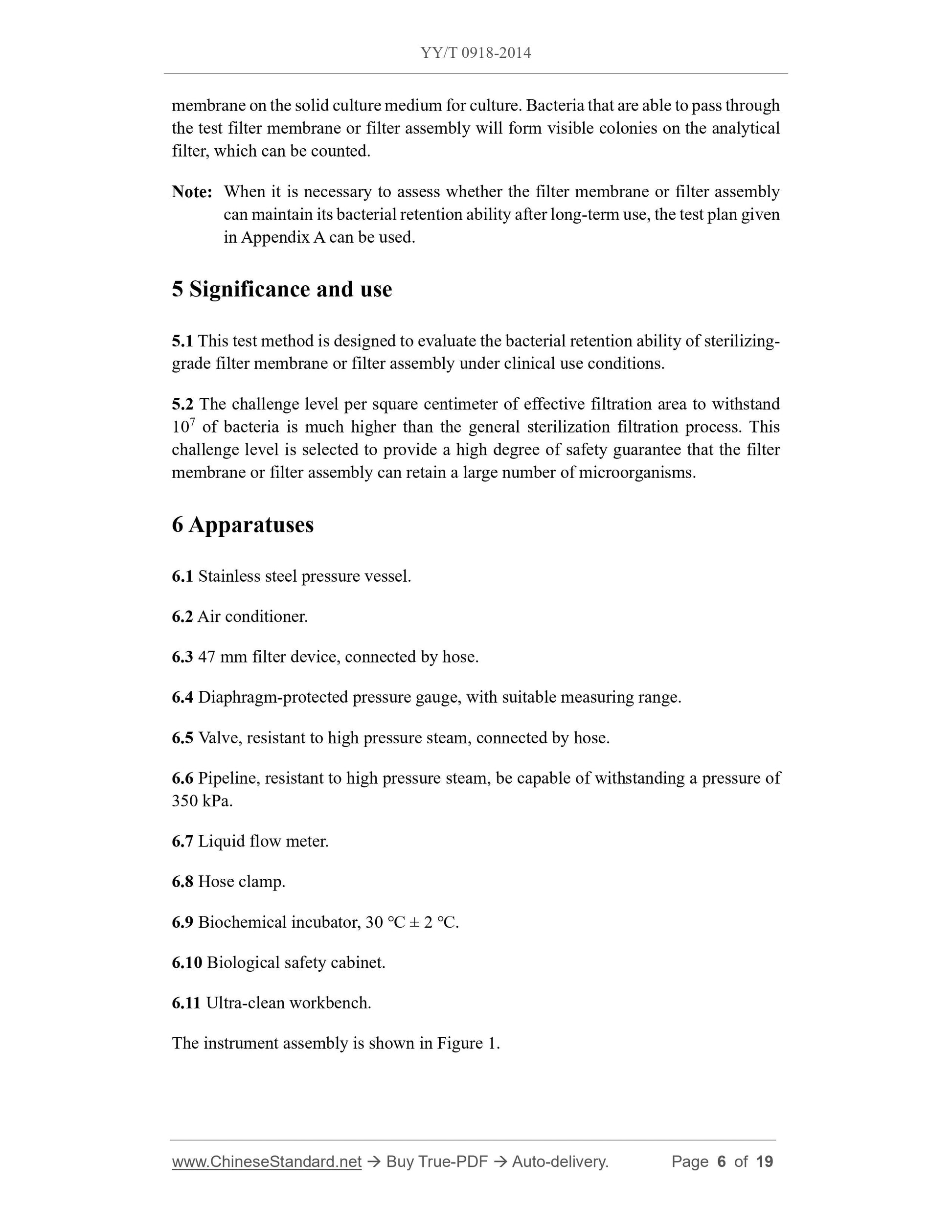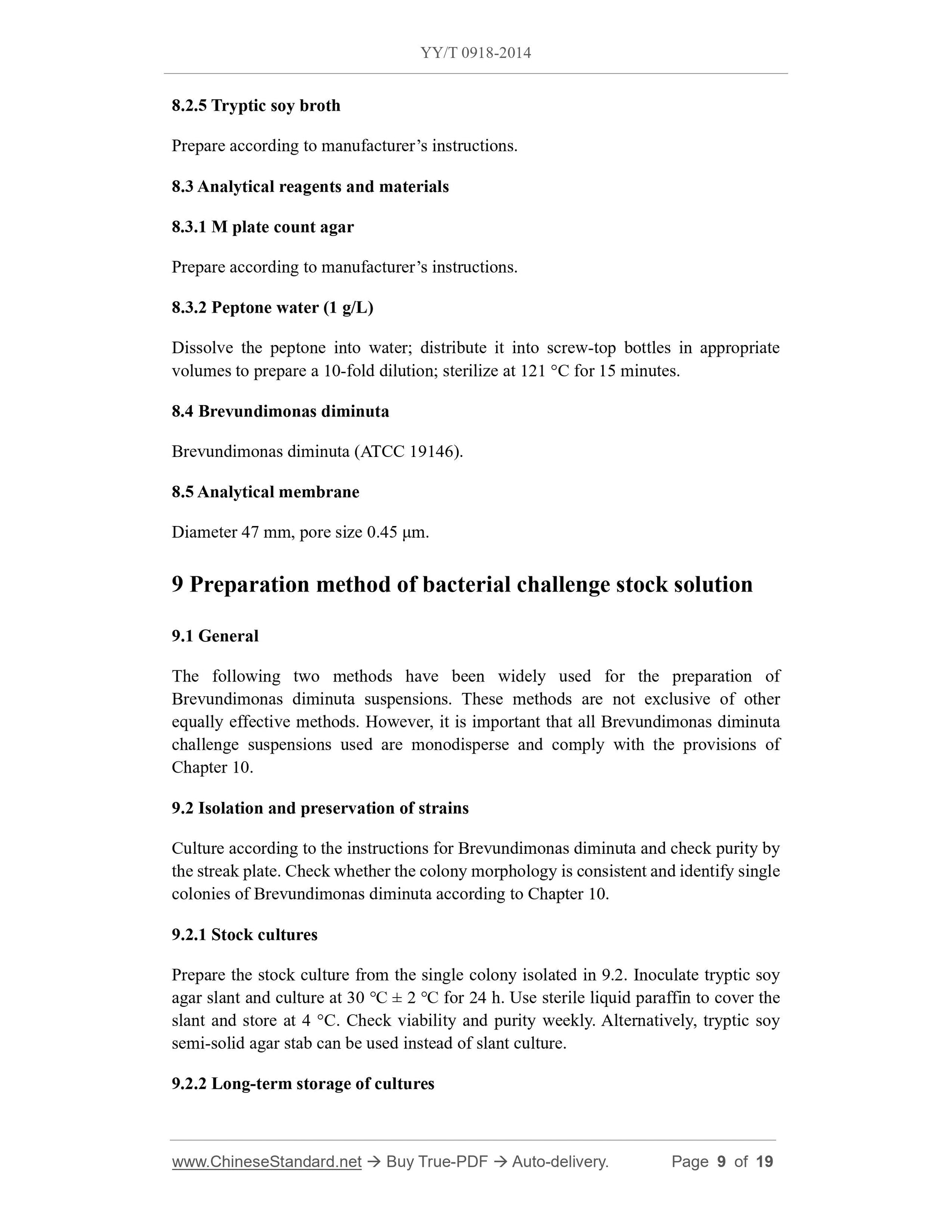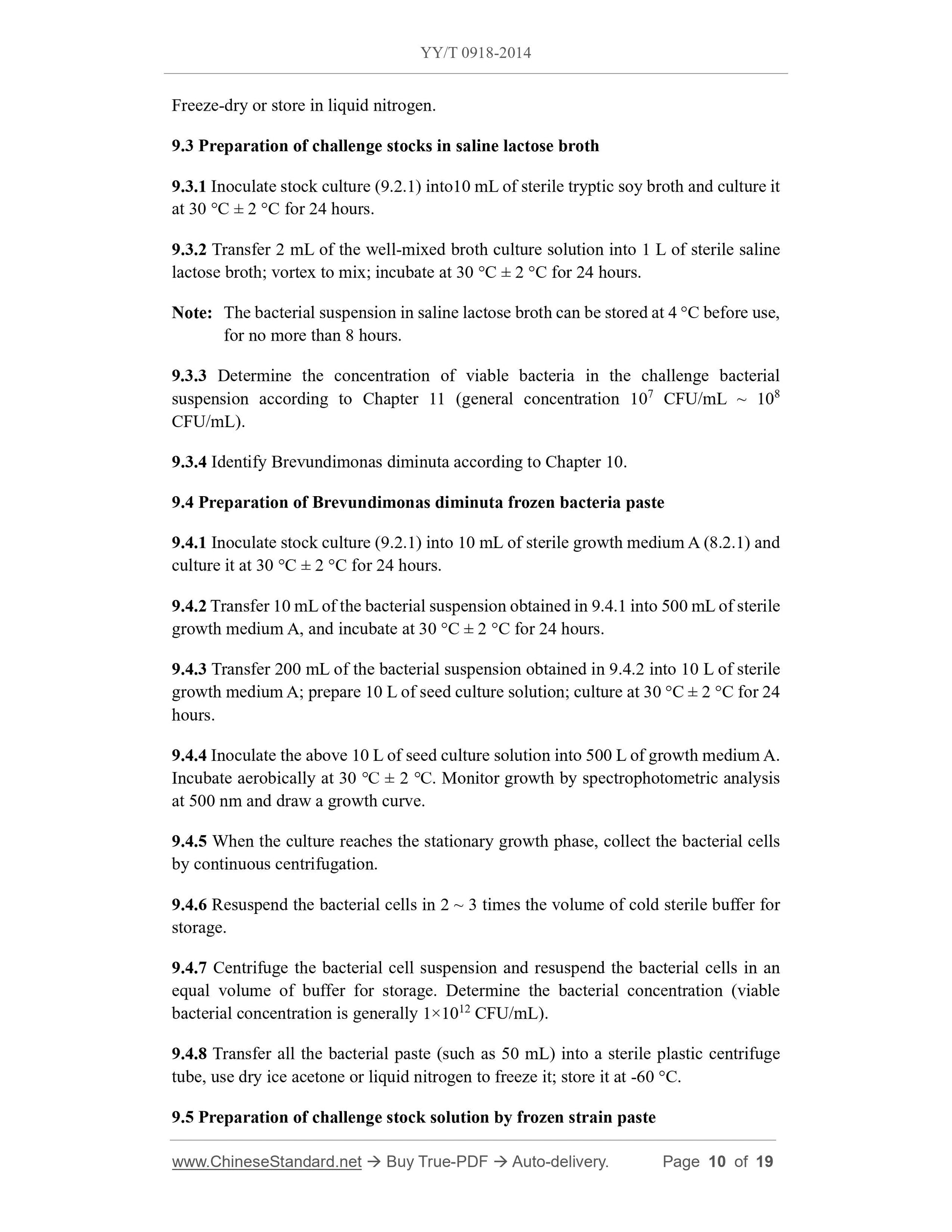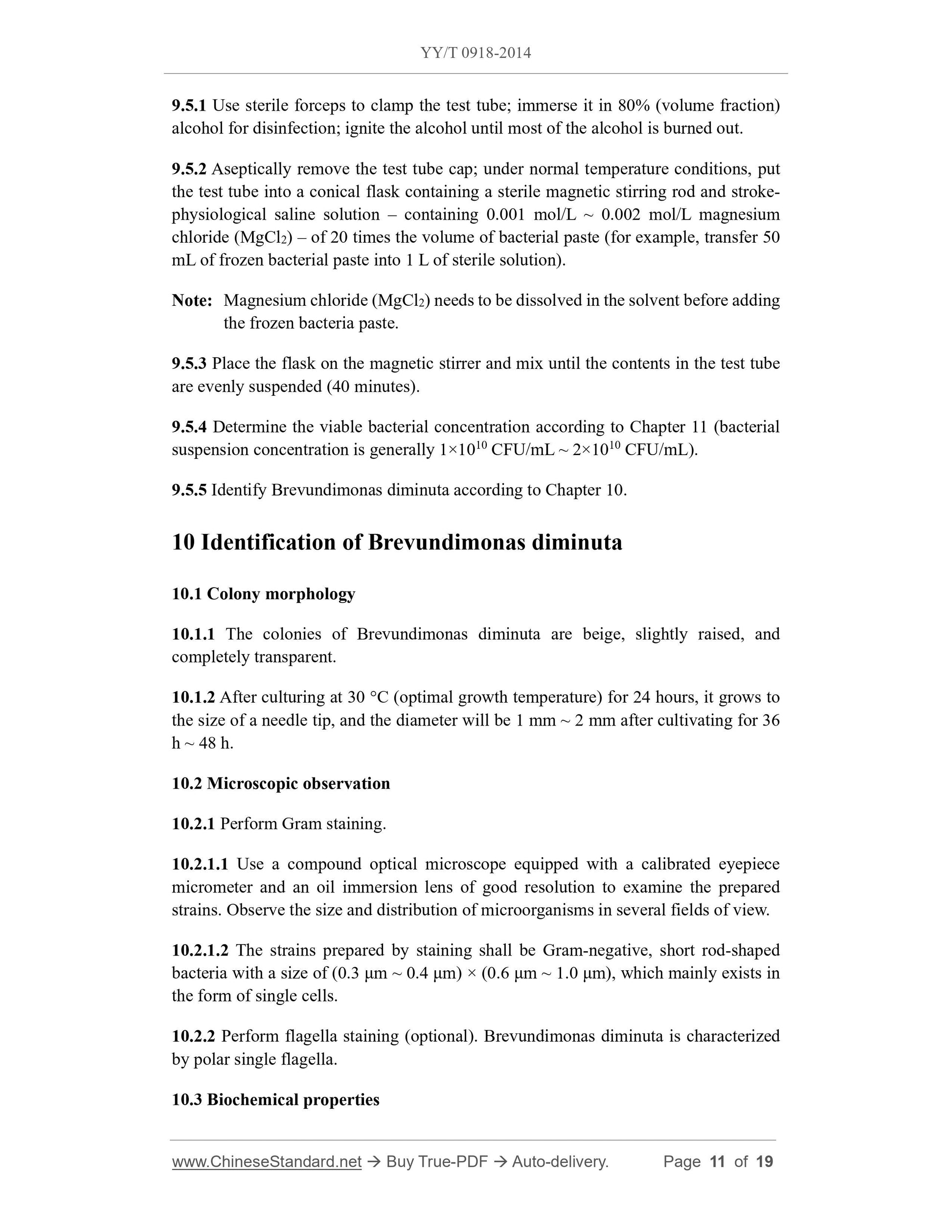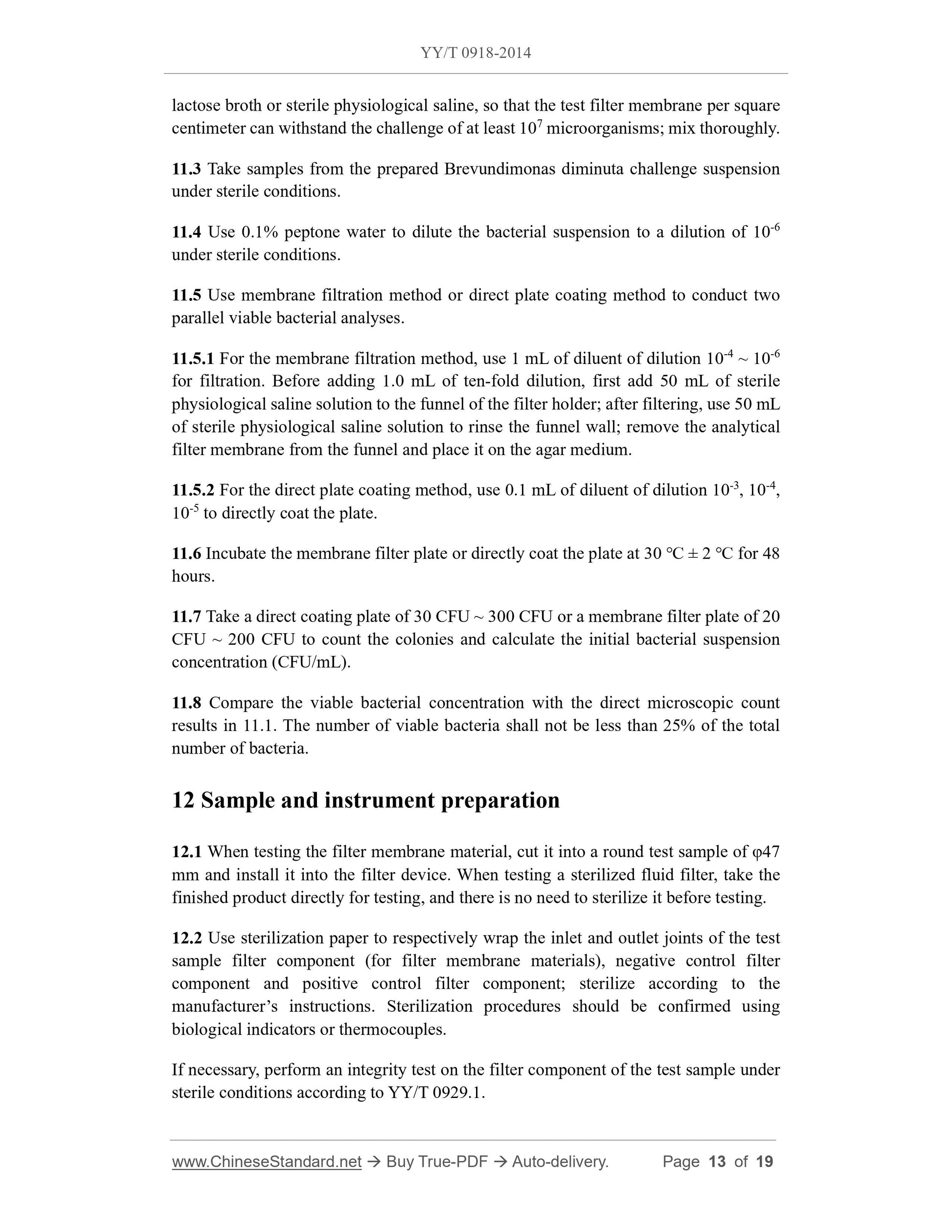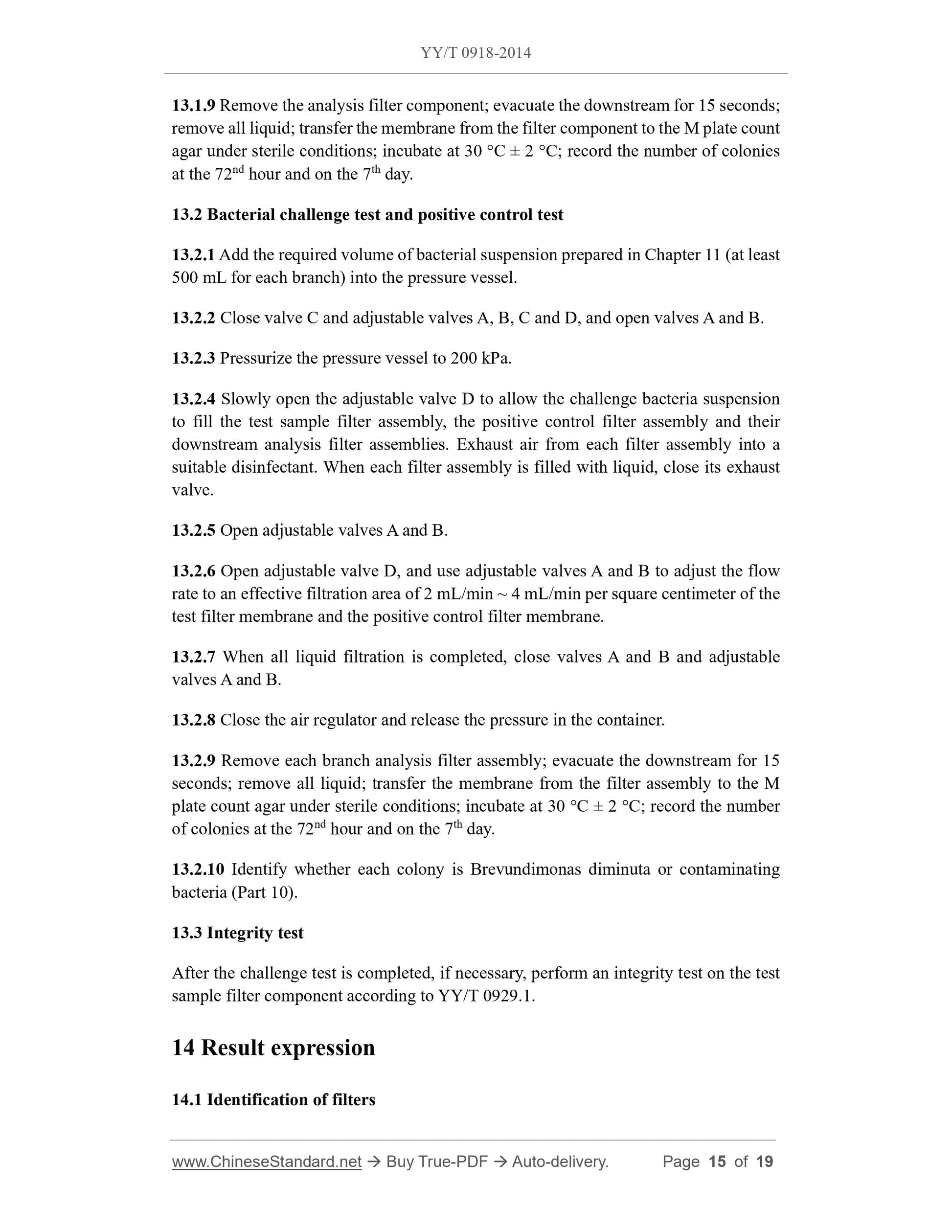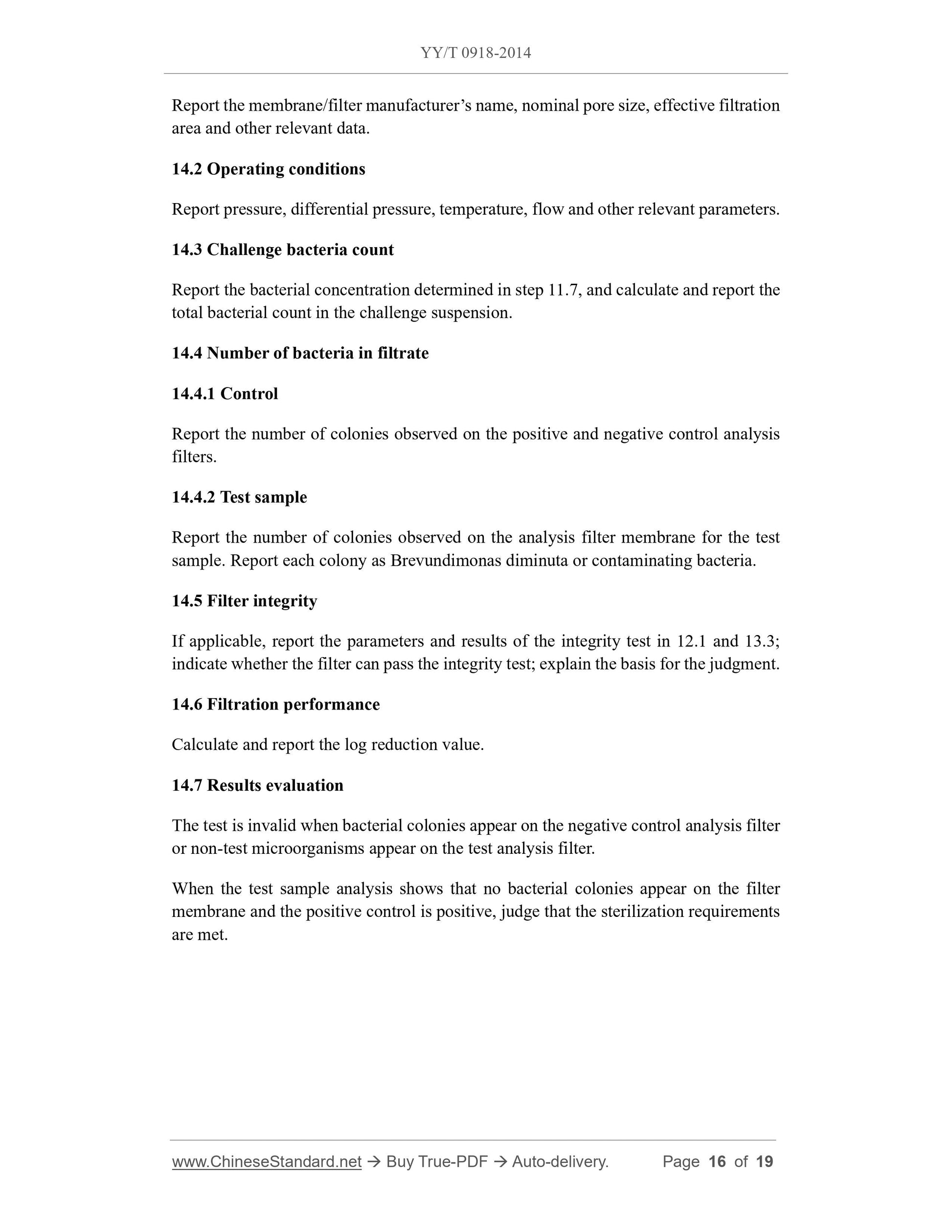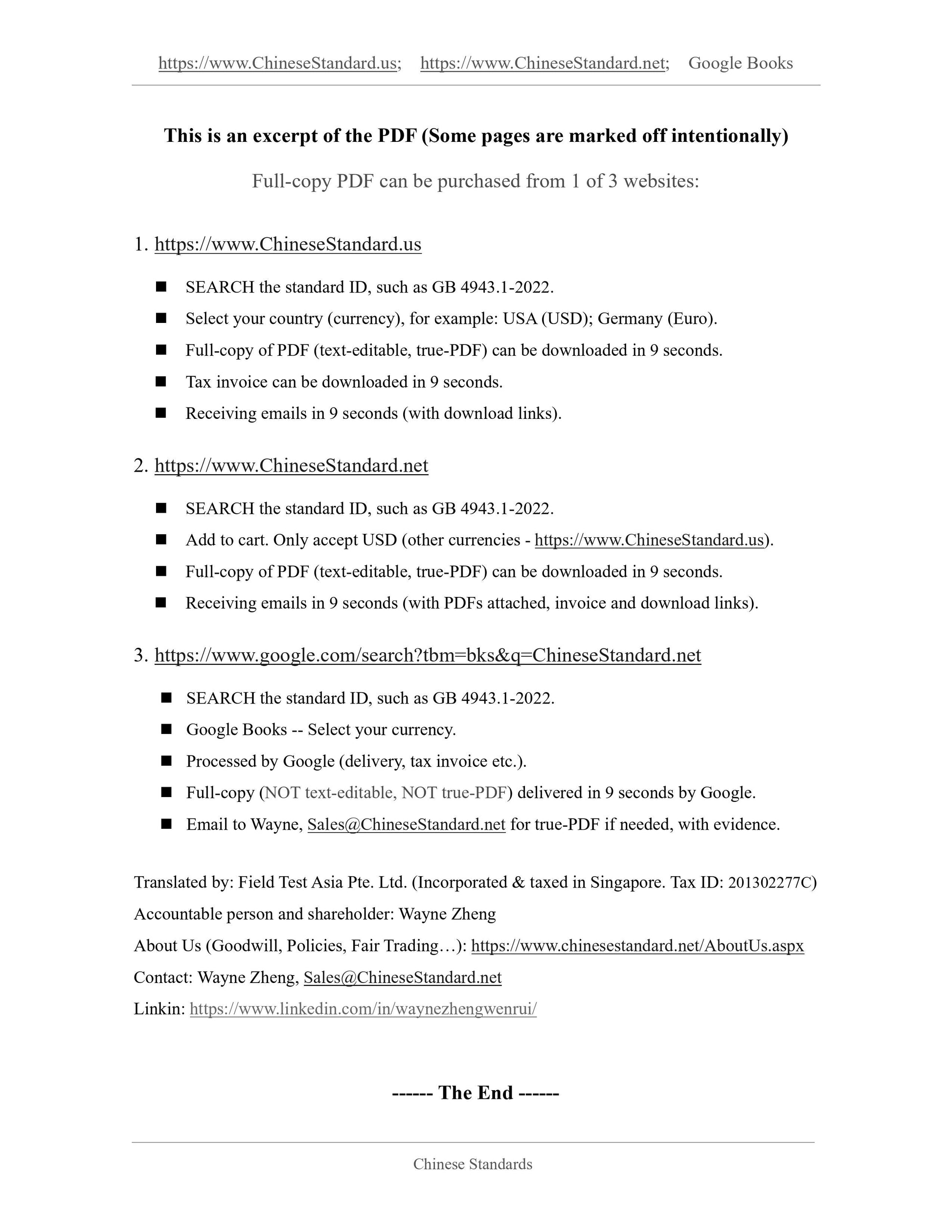PayPal, credit cards. Download editable-PDF and invoice in 1 second!
YY/T 0918-2014 English PDF (YYT0918-2014)
YY/T 0918-2014 English PDF (YYT0918-2014)
Precio habitual
$230.00 USD
Precio habitual
Precio de oferta
$230.00 USD
Precio unitario
/
por
Los gastos de envío se calculan en la pantalla de pago.
No se pudo cargar la disponibilidad de retiro
Delivery: 3 seconds. Download true-PDF + Invoice.
Get QUOTATION in 1-minute: Click YY/T 0918-2014
Historical versions: YY/T 0918-2014
Preview True-PDF (Reload/Scroll if blank)
YY/T 0918-2014: Test method for determining bacterial retention of membrane/ filter assembly utilized for infusion liquid filtration
YY/T 0918-2014
YY
PHARMACEUTICAL INDUSTRY STANDARD
OF THE PEOPLE’S REPUBLIC OF CHINA
ICS 11.040.20
C 31
Test method for determining bacterial retention of
membrane / filter assembly utilized for infusion liquid
filtration
ISSUED ON: JUNE 17, 2014
IMPLEMENTED ON: JULY 01, 2015
Issued by: China Food and Drug Administration
Table of Contents
Foreword ... 3
Introduction ... 4
1 Scope ... 5
2 Normative references ... 5
3 Terms and definitions ... 5
4 Overview of test method ... 5
5 Significance and use ... 6
6 Apparatuses ... 6
7 Purity of reagents and materials ... 7
8 Reagents and materials ... 8
9 Preparation method of bacterial challenge stock solution ... 9
10 Identification of Brevundimonas diminuta ... 11
11 Preparation of bacterial challenge suspension ... 12
12 Sample and instrument preparation ... 13
13 Test steps ... 14
14 Result expression ... 15
Appendix A (Informative) Liquid filtration membrane/filter bacterial retention cycle
test plan ... 17
Bibliography ... 19
Test method for determining bacterial retention of
membrane / filter assembly utilized for infusion liquid
filtration
1 Scope
Test method specified in this Standard applies to the evaluation of bacterial retention of
sterilizing-grade membranes or filter assemblies utilized for infusion liquid filtration
for medical devices with a nominal pore size not exceeding 0.22 μm.
2 Normative references
The following referenced documents are indispensable for the application of this
document. For dated references, only the edition cited applies. For undated references,
the latest edition of the referenced document (including any amendments) applies.
GB/T 6682, Water for analytical laboratory use - Specification and test methods
YY/T 0929.1, Sterilizing-grade filters for medical infusion equipment - Part 1:
Integrity test for fluid filters
3 Terms and definitions
For the purposes of this document, the following terms and definitions apply.
3.1
log reduction value; LRV
The 10-base logarithm of the ratio of the number of challenge microorganisms to the
number of filtrate microorganisms.
4 Overview of test method
Use a certain volume and concentration of Brevundimonas diminuta (ATCC 19146)
bacterial suspension – at a pressure difference of no more than 200 kPa on both sides
of the membrane and a flow rate of 2 mL/min ~ 4 mL/min per square centimeter of
effective filtration area (EFA) – to challenge the sterilized membrane or filter assembly
for testing, so that the final challenge level is not less than 107 CFU/cm2 EFA. After all
the filtrate is filtered through the analytical filter membrane, place the analytical filter
membrane on the solid culture medium for culture. Bacteria that are able to pass through
the test filter membrane or filter assembly will form visible colonies on the analytical
filter, which can be counted.
Note: When it is necessary to assess whether the filter membrane or filter assembly
can maintain its bacterial retention ability after long-term use, the test plan given
in Appendix A can be used.
5 Significance and use
5.1 This test method is designed to evaluate the bacterial retention ability of sterilizing-
grade filter membrane or filter assembly under clinical use conditions.
5.2 The challenge level per square centimeter of effective filtration area to withstand
107 of bacteria is much higher than the general sterilization filtration process. This
challenge level is selected to provide a high degree of safety guarantee that the filter
membrane or filter assembly can retain a large number of microorganisms.
6 Apparatuses
6.1 Stainless steel pressure vessel.
6.2 Air conditioner.
6.3 47 mm filter device, connected by hose.
6.4 Diaphragm-protected pressure gauge, with suitable measuring range.
6.5 Valve, resistant to high pressure steam, connected by hose.
6.6 Pipeline, resistant to high pressure steam, be capable of withstanding a pressure of
350 kPa.
6.7 Liquid flow meter.
6.8 Hose clamp.
6.9 Biochemical incubator, 30 ℃ ± 2 ℃.
6.10 Biological safety cabinet.
6.11 Ultra-clean workbench.
The instrument assembly is shown in Figure 1.
8.2.5 Tryptic soy broth
Prepare according to manufacturer’s instructions.
8.3 Analytical reagents and materials
8.3.1 M plate count agar
Prepare according to manufacturer’s instructions.
8.3.2 Peptone water (1 g/L)
Dissolve the peptone into water; distribute it into screw-top bottles in appropriate
volumes to prepare a 10-fold dilution; sterilize at 121 °C for 15 minutes.
8.4 Brevundimonas diminuta
Brevundimonas diminuta (ATCC 19146).
8.5 Analytical membrane
Diameter 47 mm, pore size 0.45 μm.
9 Preparation method of bacterial challenge stock solution
9.1 General
The following two methods have been widely used for the preparation of
Brevundimonas diminuta suspensions. These methods are not exclusive of other
equally effective methods. However, it is important that all Brevundimonas diminuta
challenge suspensions used are monodisperse and comply with the provisions of
Chapter 10.
9.2 Isolation and preservation of strains
Culture according to the instructions for Brevundimonas diminuta and check purity by
the streak plate. Check whether the colony morphology is consistent and identify single
colonies of Brevundimonas diminuta according to Chapter 10.
9.2.1 Stock cultures
Prepare the stock culture from the single colony isolated in 9.2. Inoculate tryptic soy
agar slant and culture at 30 ℃ ± 2 ℃ for 24 h. Use sterile liquid paraffin to cover the
slant and store at 4 °C. Check viability and purity weekly. Alternatively, tryptic soy
semi-solid agar stab can be used instead of slant culture.
9.2.2 Long-term storage of cultures
Freeze-dry or store in liquid nitrogen.
9.3 Preparation of challenge stocks in saline lactose broth
9.3.1 Inoculate stock culture (9.2.1) into10 mL of sterile tryptic soy broth and culture it
at 30 °C ± 2 °C for 24 hours.
9.3.2 Transfer 2 mL of the well-mixed broth culture solution into 1 L of sterile saline
lactose broth; vortex to mix; incubate at 30 °C ± 2 °C for 24 hours.
Note: The bacterial suspension in saline lactose broth can be stored at 4 °C before use,
for no more than 8 hours.
9.3.3 Determine the concentration of viable bacteria in the challenge bacterial
suspension according to Chapter 11 (general concentration 107 CFU/mL ~ 108
CFU/mL).
9.3.4 Identify Brevundimonas diminuta according to Chapter 10.
9.4 Preparation of Brevundimonas diminuta frozen bacteria paste
9.4.1 Inoculate stock culture (9.2.1) into 10 mL of sterile growth medium A (8.2.1) and
culture it at 30 °C ± 2 °C for 24 hours.
9.4.2 Transfer 10 mL of the bacterial suspension obtained in 9.4.1 into 500 mL of sterile
growth medium A, and incubate at 30 °C ± 2 °C for 24 hours.
9.4.3 Transfer 200 mL of the bacterial suspension obtained in 9.4.2 into 10 L of sterile
growth medium A; prepare 10 L of seed culture solution; culture at 30 °C ± 2 °C for 24
hours.
9.4.4 Inoculate the above 10 L of seed culture solution into 500 L of growth medium A.
Incubate aerobically at 30 ℃ ± 2 ℃. Monitor growth by spectrophotometric analysis
at 500 nm and draw a growth curve.
9.4.5 When the culture reaches the stationary growth phase, collect the bacterial cells
by continuous centrifugation.
9.4.6 Resuspend the bacterial cells in 2 ~ 3 times the volume of cold sterile buffer for
storag...
Get QUOTATION in 1-minute: Click YY/T 0918-2014
Historical versions: YY/T 0918-2014
Preview True-PDF (Reload/Scroll if blank)
YY/T 0918-2014: Test method for determining bacterial retention of membrane/ filter assembly utilized for infusion liquid filtration
YY/T 0918-2014
YY
PHARMACEUTICAL INDUSTRY STANDARD
OF THE PEOPLE’S REPUBLIC OF CHINA
ICS 11.040.20
C 31
Test method for determining bacterial retention of
membrane / filter assembly utilized for infusion liquid
filtration
ISSUED ON: JUNE 17, 2014
IMPLEMENTED ON: JULY 01, 2015
Issued by: China Food and Drug Administration
Table of Contents
Foreword ... 3
Introduction ... 4
1 Scope ... 5
2 Normative references ... 5
3 Terms and definitions ... 5
4 Overview of test method ... 5
5 Significance and use ... 6
6 Apparatuses ... 6
7 Purity of reagents and materials ... 7
8 Reagents and materials ... 8
9 Preparation method of bacterial challenge stock solution ... 9
10 Identification of Brevundimonas diminuta ... 11
11 Preparation of bacterial challenge suspension ... 12
12 Sample and instrument preparation ... 13
13 Test steps ... 14
14 Result expression ... 15
Appendix A (Informative) Liquid filtration membrane/filter bacterial retention cycle
test plan ... 17
Bibliography ... 19
Test method for determining bacterial retention of
membrane / filter assembly utilized for infusion liquid
filtration
1 Scope
Test method specified in this Standard applies to the evaluation of bacterial retention of
sterilizing-grade membranes or filter assemblies utilized for infusion liquid filtration
for medical devices with a nominal pore size not exceeding 0.22 μm.
2 Normative references
The following referenced documents are indispensable for the application of this
document. For dated references, only the edition cited applies. For undated references,
the latest edition of the referenced document (including any amendments) applies.
GB/T 6682, Water for analytical laboratory use - Specification and test methods
YY/T 0929.1, Sterilizing-grade filters for medical infusion equipment - Part 1:
Integrity test for fluid filters
3 Terms and definitions
For the purposes of this document, the following terms and definitions apply.
3.1
log reduction value; LRV
The 10-base logarithm of the ratio of the number of challenge microorganisms to the
number of filtrate microorganisms.
4 Overview of test method
Use a certain volume and concentration of Brevundimonas diminuta (ATCC 19146)
bacterial suspension – at a pressure difference of no more than 200 kPa on both sides
of the membrane and a flow rate of 2 mL/min ~ 4 mL/min per square centimeter of
effective filtration area (EFA) – to challenge the sterilized membrane or filter assembly
for testing, so that the final challenge level is not less than 107 CFU/cm2 EFA. After all
the filtrate is filtered through the analytical filter membrane, place the analytical filter
membrane on the solid culture medium for culture. Bacteria that are able to pass through
the test filter membrane or filter assembly will form visible colonies on the analytical
filter, which can be counted.
Note: When it is necessary to assess whether the filter membrane or filter assembly
can maintain its bacterial retention ability after long-term use, the test plan given
in Appendix A can be used.
5 Significance and use
5.1 This test method is designed to evaluate the bacterial retention ability of sterilizing-
grade filter membrane or filter assembly under clinical use conditions.
5.2 The challenge level per square centimeter of effective filtration area to withstand
107 of bacteria is much higher than the general sterilization filtration process. This
challenge level is selected to provide a high degree of safety guarantee that the filter
membrane or filter assembly can retain a large number of microorganisms.
6 Apparatuses
6.1 Stainless steel pressure vessel.
6.2 Air conditioner.
6.3 47 mm filter device, connected by hose.
6.4 Diaphragm-protected pressure gauge, with suitable measuring range.
6.5 Valve, resistant to high pressure steam, connected by hose.
6.6 Pipeline, resistant to high pressure steam, be capable of withstanding a pressure of
350 kPa.
6.7 Liquid flow meter.
6.8 Hose clamp.
6.9 Biochemical incubator, 30 ℃ ± 2 ℃.
6.10 Biological safety cabinet.
6.11 Ultra-clean workbench.
The instrument assembly is shown in Figure 1.
8.2.5 Tryptic soy broth
Prepare according to manufacturer’s instructions.
8.3 Analytical reagents and materials
8.3.1 M plate count agar
Prepare according to manufacturer’s instructions.
8.3.2 Peptone water (1 g/L)
Dissolve the peptone into water; distribute it into screw-top bottles in appropriate
volumes to prepare a 10-fold dilution; sterilize at 121 °C for 15 minutes.
8.4 Brevundimonas diminuta
Brevundimonas diminuta (ATCC 19146).
8.5 Analytical membrane
Diameter 47 mm, pore size 0.45 μm.
9 Preparation method of bacterial challenge stock solution
9.1 General
The following two methods have been widely used for the preparation of
Brevundimonas diminuta suspensions. These methods are not exclusive of other
equally effective methods. However, it is important that all Brevundimonas diminuta
challenge suspensions used are monodisperse and comply with the provisions of
Chapter 10.
9.2 Isolation and preservation of strains
Culture according to the instructions for Brevundimonas diminuta and check purity by
the streak plate. Check whether the colony morphology is consistent and identify single
colonies of Brevundimonas diminuta according to Chapter 10.
9.2.1 Stock cultures
Prepare the stock culture from the single colony isolated in 9.2. Inoculate tryptic soy
agar slant and culture at 30 ℃ ± 2 ℃ for 24 h. Use sterile liquid paraffin to cover the
slant and store at 4 °C. Check viability and purity weekly. Alternatively, tryptic soy
semi-solid agar stab can be used instead of slant culture.
9.2.2 Long-term storage of cultures
Freeze-dry or store in liquid nitrogen.
9.3 Preparation of challenge stocks in saline lactose broth
9.3.1 Inoculate stock culture (9.2.1) into10 mL of sterile tryptic soy broth and culture it
at 30 °C ± 2 °C for 24 hours.
9.3.2 Transfer 2 mL of the well-mixed broth culture solution into 1 L of sterile saline
lactose broth; vortex to mix; incubate at 30 °C ± 2 °C for 24 hours.
Note: The bacterial suspension in saline lactose broth can be stored at 4 °C before use,
for no more than 8 hours.
9.3.3 Determine the concentration of viable bacteria in the challenge bacterial
suspension according to Chapter 11 (general concentration 107 CFU/mL ~ 108
CFU/mL).
9.3.4 Identify Brevundimonas diminuta according to Chapter 10.
9.4 Preparation of Brevundimonas diminuta frozen bacteria paste
9.4.1 Inoculate stock culture (9.2.1) into 10 mL of sterile growth medium A (8.2.1) and
culture it at 30 °C ± 2 °C for 24 hours.
9.4.2 Transfer 10 mL of the bacterial suspension obtained in 9.4.1 into 500 mL of sterile
growth medium A, and incubate at 30 °C ± 2 °C for 24 hours.
9.4.3 Transfer 200 mL of the bacterial suspension obtained in 9.4.2 into 10 L of sterile
growth medium A; prepare 10 L of seed culture solution; culture at 30 °C ± 2 °C for 24
hours.
9.4.4 Inoculate the above 10 L of seed culture solution into 500 L of growth medium A.
Incubate aerobically at 30 ℃ ± 2 ℃. Monitor growth by spectrophotometric analysis
at 500 nm and draw a growth curve.
9.4.5 When the culture reaches the stationary growth phase, collect the bacterial cells
by continuous centrifugation.
9.4.6 Resuspend the bacterial cells in 2 ~ 3 times the volume of cold sterile buffer for
storag...
Share












